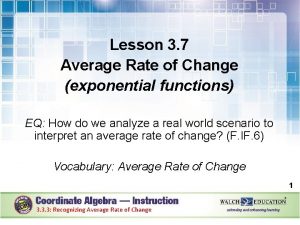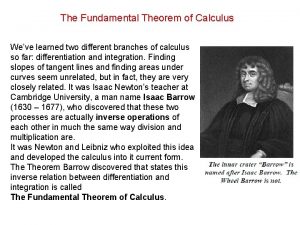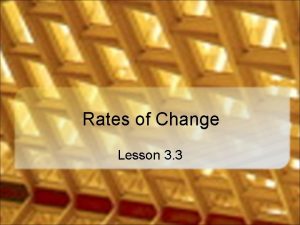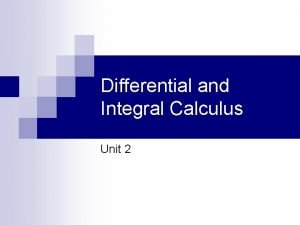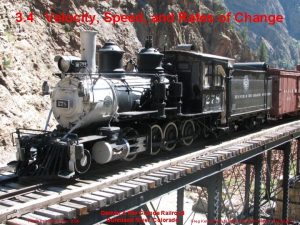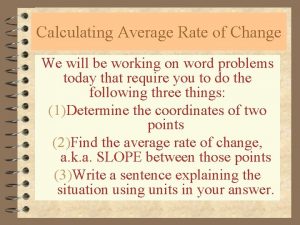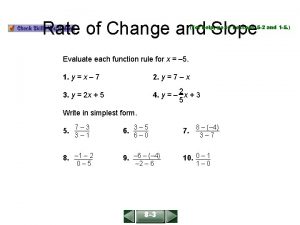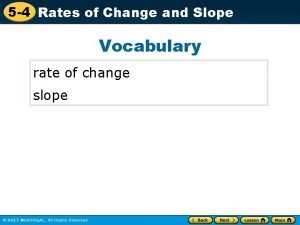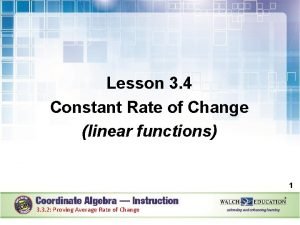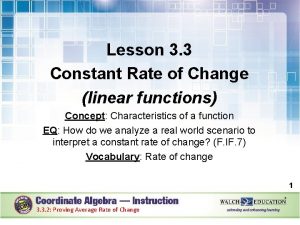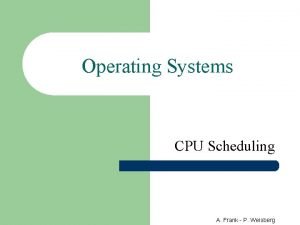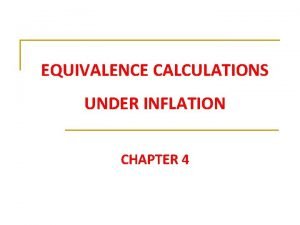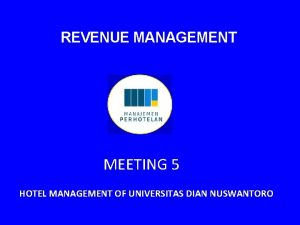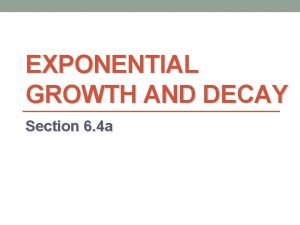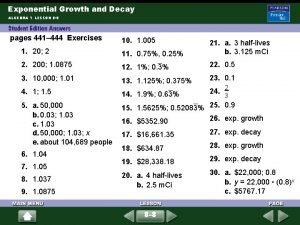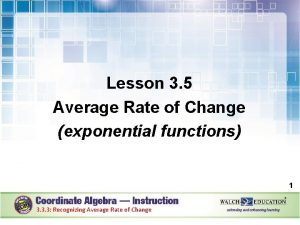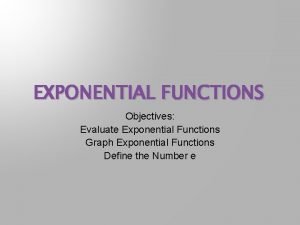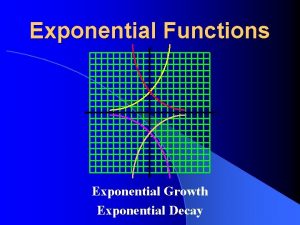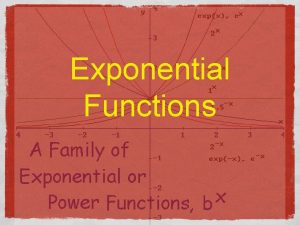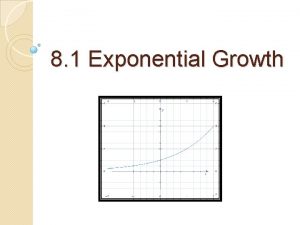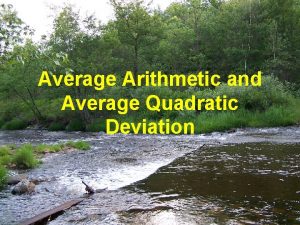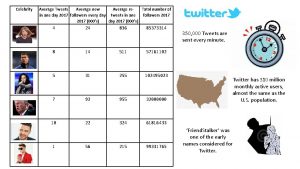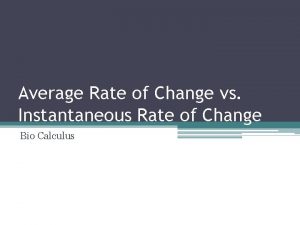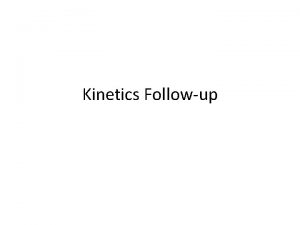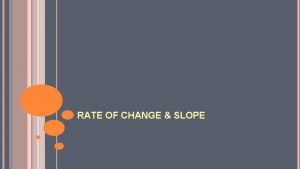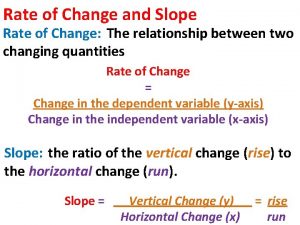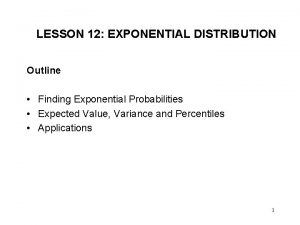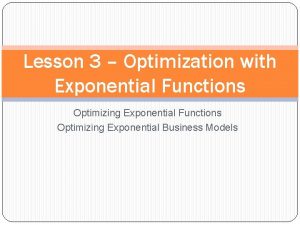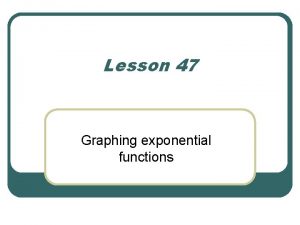Lesson 3 7 Average Rate of Change exponential























- Slides: 23

Lesson 3. 7 Average Rate of Change (exponential functions) EQ: How do we analyze a real world scenario to interpret an average rate of change? (F. IF. 6) Vocabulary: Average Rate of Change 1 3. 3. 3: Recognizing Average Rate of Change

Introduction In the previous unit, we found the constant rate of change of linear equations and functions using the slope formula, m= The slope of a line is the ratio of the change in y-values to the change in x-values. The rate of change can be determined from graphs, tables, and equations themselves. In this lesson, we will extend our understanding of the slope of linear functions to that of intervals of exponential functions. 2 3. 3. 3 Recognizing Average Rate of Change

Constant Rate of Change VS. Average Rate of Change

4 3. 3. 3: Recognizing Average Rate of Change

Key Concepts, continued • An interval is a continuous portion of a function. • The rate of change of an interval is the average rate of change for that period. • Intervals can be noted using the format [a, b], where a represents the initial x value of the interval and b represents the final x value of the interval. Another way to state the interval is a ≤ x ≤ b. • For example, the interval [2, 7] means the portion of the function where x = 2 through x = 7. You would use the points (2, y) & (7, y) in the slope formula when calculating the rate of change for the function. 3. 3. 3 Recognizing Average Rate of Change 5

Key Concepts, continued Steps to Calculating Average Rate of Change 6 3. 3. 3: Recognizing Average Rate of Change

Guided Practice Example 1 In 2008, about 66 million Year (x) U. S. households had both 2008 landline phones and cell 2009 phones. Use the table 2010 to the right to calculate and interpret the rate of 2011 change for the interval [2008, 2011]. Households in millions (f(x)) 66 61 56 51 7 3. 3. 3: Recognizing Average Rate of Change

Guided Practice: Example 1, continued 1. Determine the interval to be observed. The interval to be observed is [2008, 2011], or where 2008 ≤ x ≤ 2011. 2. Determine (x 1, y 1). The initial x-value is 2008 and the corresponding y-value is 66; therefore, (x 1, y 1) is (2008, 66). 3. Determine (x 2, y 2). The ending x-value is 2011 and the corresponding y-value is 51; therefore, (x 2, y 2) is (2011, 51). 8 3. 3. 3: Recognizing Average Rate of Change

Guided Practice: Example 1, continued 4. Substitute (x 1, y 1) and (x 2, y 2) into the slope formula to calculate the rate of change. Slope formula Substitute (2008, 66) and (2011, 51) for (x 1, y 1) and (x 2, y 2). Simplify as needed. = – 5 9 3. 3. 3: Recognizing Average Rate of Change

Guided Practice: Example 1, continued 5. Interpret your answer in the context of the problem. The average rate of change for the interval [2008, 2011] is 5 million households per year. Meaning, from 2008 to 2011 there were 5 million households less per year who no longer had both a landline and cell phone. 10 3. 3. 3: Recognizing Average Rate of Change

You Try 1 The table below represents a type of bacteria that doubles every 36 hours. A Petri dish starts out with 12 of these bacteria. Calculate and interpret the average rate of change over the interval [2, 5]. 3. 3. 3: Recognizing Average Rate of Change 11

Guided Practice Example 2 Jasper has invested an amount of money into a savings account. The graph to the right shows the value of his investment over a period of time. What is the rate of change for the interval [1, 3]? 12 3. 3. 3: Recognizing Average Rate of Change

Guided Practice: Example 2, continued 1. Determine the interval to be observed. The interval to observe is [1, 3], or where 1 ≤ x ≤ 3. 2. Identify the starting point of the interval. The x-value of the starting point is 1. The corresponding yvalue is approximately 550. The starting point of the interval is (1, 550). 3. Identify the ending point of the interval. The x-value for the ending point is 3. The corresponding yvalue is approximately 1, 100. The ending point of the interval is (3, 1100). 13 3. 3. 3: Recognizing Average Rate of Change

Guided Practice: Example 2, continued 14 3. 3. 3: Recognizing Average Rate of Change

Guided Practice: Example 2, continued 4. Substitute (1, 550) and (3, 1100) into the slope formula to calculate the rate of change. Slope formula Substitute (1, 550) and (3, 1100) for (x 1, y 1) and (x 2, y 2). Simplify as needed. = 275 3. 3. 3: Recognizing Average Rate of Change 15

Guided Practice: Example 2, continued 5. Interpret your answer in the context of the problem. The average rate of change for this function over the interval [1, 3] is approximately $275 per year. Meaning, from year 1 to year 3, Jasper’s average investment value per year was $275. 16 3. 3. 3: Recognizing Average Rate of Change

Guided Practice Example 3 Jasper is curious about how the rate of change differs for the interval [3, 6]. Calculate the rate of change using the graph from Example 2. 17 3. 3. 3: Recognizing Average Rate of Change

Guided Practice: Example 3, continued 1. Determine the interval to be observed. The interval to observe is [3, 6], or where 3 ≤ x ≤ 6. 2. Identify the starting point of the interval. The x-value of the starting point is 3. The corresponding y-value is approximately 1, 100. The starting point of the interval is (3, 1100). 3. Identify the ending point of the interval. The x-value for the ending point is 6. The corresponding y-value is approximately 3, 100. The ending point of the interval is (6, 3100). 18 3. 3. 3: Recognizing Average Rate of Change

Guided Practice: Example 3, continued 19 3. 3. 3: Recognizing Average Rate of Change

Guided Practice: Example 3, continued 4. Substitute (3, 1100) and (6, 3100) into the slope formula to calculate the rate of change. Slope formula Substitute (3, 1100) and (6, 3100) for (x 1, y 1) and (x 2, y 2). Simplify as needed. 20 3. 3. 3: Recognizing Average Rate of Change

Guided Practice: Example 3, continued 5. Interpret your answer in the context of the problem. The rate of change for this function over the interval [3, 6] is approximately $666. 67 per year. Meaning, from year 3 to year 6, Jasper’s average investment value per year was $666. 67. Notice that the rate of change for the interval [3, 6] is much steeper than that of the interval [1, 3]. What can you conclude about Jasper’s investment value over time? 21 3. 3. 3: Recognizing Average Rate of Change

You Try 2 Each year, volunteers at a three-day music festival record the number of people who camp on the festival grounds. The graph below shows the number of campers for each of the last 20 years. Calculate and interpret the average rate of change over the intervals [3, 9] and [9, 16]. 3. 3. 3: Recognizing Average Rate of Change 22

Linear Rate of Change • You choose your two points • Rate of Change is Constant VS. Both use the slope formula: Non-linear Rate of Change • You are told by the interval which two points to use • Rate of Change is different at different intervals
 Average rate of change exponential function
Average rate of change exponential function The fundamental theorem of calculus
The fundamental theorem of calculus Average of change formula
Average of change formula How to find average rate of change on a graph
How to find average rate of change on a graph Calculus average rate of change
Calculus average rate of change Average rate of change
Average rate of change Is distance the derivative of velocity
Is distance the derivative of velocity Calculating average rate of change
Calculating average rate of change Unit 6 lesson 1 rate of change and slope
Unit 6 lesson 1 rate of change and slope Rate of change vocabulary
Rate of change vocabulary Rate of change lesson
Rate of change lesson Rate of change and slope lesson 3-2
Rate of change and slope lesson 3-2 Motion in a straight line
Motion in a straight line Exponential average formula in os
Exponential average formula in os How to calculate average inflation rate using cpi
How to calculate average inflation rate using cpi Average resting heart rate for men
Average resting heart rate for men Average rate of reaction formula
Average rate of reaction formula I have to present
I have to present Average tax rate example
Average tax rate example Heart beat normal range
Heart beat normal range Revpar hotel adalah
Revpar hotel adalah Organism population community ecosystem
Organism population community ecosystem Law of exponential change
Law of exponential change Practice 8-8 exponential growth and decay
Practice 8-8 exponential growth and decay
